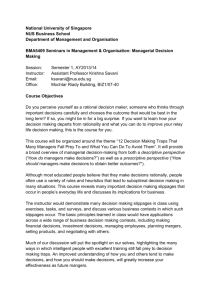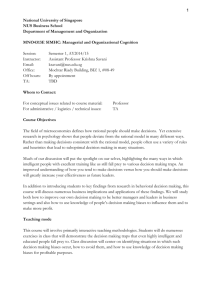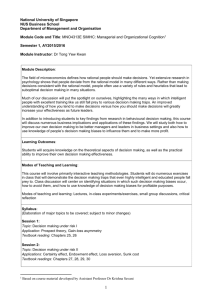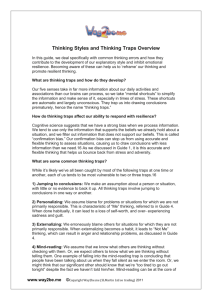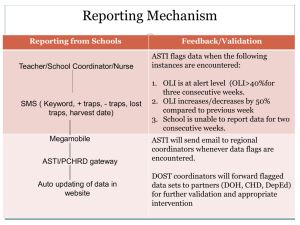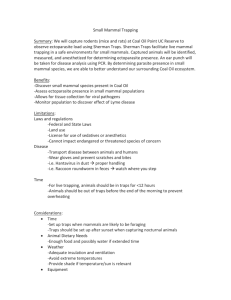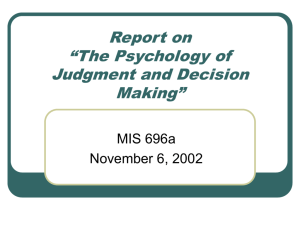Managerial Decision Making - NUS Business School
advertisement
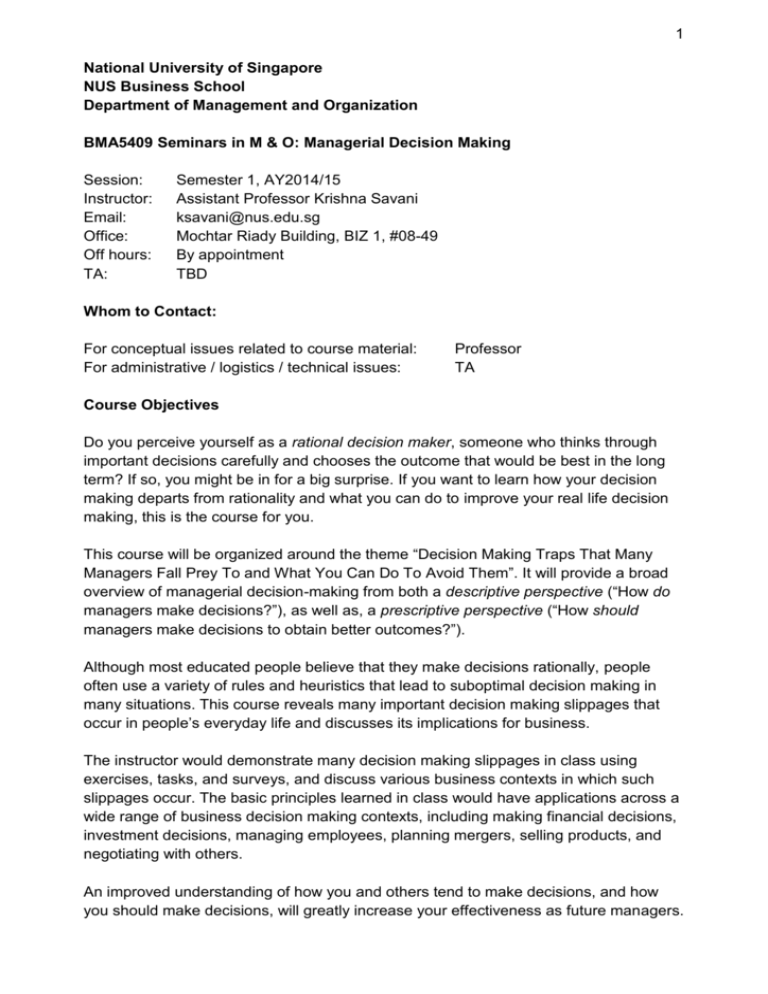
1 National University of Singapore NUS Business School Department of Management and Organization BMA5409 Seminars in M & O: Managerial Decision Making Session: Instructor: Email: Office: Off hours: TA: Semester 1, AY2014/15 Assistant Professor Krishna Savani ksavani@nus.edu.sg Mochtar Riady Building, BIZ 1, #08-49 By appointment TBD Whom to Contact: For conceptual issues related to course material: For administrative / logistics / technical issues: Professor TA Course Objectives Do you perceive yourself as a rational decision maker, someone who thinks through important decisions carefully and chooses the outcome that would be best in the long term? If so, you might be in for a big surprise. If you want to learn how your decision making departs from rationality and what you can do to improve your real life decision making, this is the course for you. This course will be organized around the theme “Decision Making Traps That Many Managers Fall Prey To and What You Can Do To Avoid Them”. It will provide a broad overview of managerial decision-making from both a descriptive perspective (“How do managers make decisions?”), as well as, a prescriptive perspective (“How should managers make decisions to obtain better outcomes?”). Although most educated people believe that they make decisions rationally, people often use a variety of rules and heuristics that lead to suboptimal decision making in many situations. This course reveals many important decision making slippages that occur in people’s everyday life and discusses its implications for business. The instructor would demonstrate many decision making slippages in class using exercises, tasks, and surveys, and discuss various business contexts in which such slippages occur. The basic principles learned in class would have applications across a wide range of business decision making contexts, including making financial decisions, investment decisions, managing employees, planning mergers, selling products, and negotiating with others. An improved understanding of how you and others tend to make decisions, and how you should make decisions, will greatly increase your effectiveness as future managers. 2 Teaching mode This course will involve primarily interactive teaching methodologies. Students will do numerous exercises in class that will demonstrate the decision making traps that even highly intelligent and educated people fall prey to. Class discussion will center on identifying situations in which such decision making biases occur, how to avoid them, and how to use knowledge of decision making biases for profitable purposes. Assessments (100% Continuous Assessments): Attendance: 16 points As this course is primarily learned through in-class demonstrations of decision traps and subsequent discussions, you are expected to attend all sessions. Attendance is absolutely necessary for understanding the concepts covered in the course. Each absence (barring emergencies excused over e-mail before the beginning of class) will lead to a 4 point deduction from the attendance score. If you are absent for more than four classes, the additional attendance point deductions beyond 16 points would be subtracted from the other continuous assessments components. Participation: 24 points Students will receive 2 points for making at least one substantial contribution in each class from Week 1 to 12, either in the form of a thoughtful question, a thoughtful response to someone else’s question, or a thoughtful analysis related to the traps being discussed. Please put your name tag in front of your seat in every class session to assist us in assessing class participation. Weekly introspection paragraphs: 30 points As an important goal of this course is that students apply the concepts they learn in class to their real life decision making from the very beginning, both in your personal and professional lives. To encourage this, you would be asked to submit a one or two paragraph description (maximum 200 words) of an instance in which you found yourself or someone else falling in or avoiding one of the decision traps discussed in class in the past week. Examples already mentioned in class, either by the professor or by other students, cannot be reused for the weekly introspection submissions. Decision traps discussed in previous weeks before the most recent class session, or decision traps not yet discussed, are also not allowed. This paragraph has to be submitted online before the class starting time. Submissions time-stamped after this time will be discarded. No submissions would be due the week after guest lectures. 3 Submissions will be graded on the following criteria: (1) Analysis: Event actually reflects the decision making trap that has been claimed to occur (2 points); and (2) Suggestions for improvement: How the actor can avoid falling prey to the decision making trap (1 point). An example would be provided in the first class. Qualitative feedback would be provided for submissions in alternate weeks. Final essay paper: 30 points A short final essay paper (5 pages, double-spaced) would ask you to try to challenge the confirmation bias in your everyday interactions with friends and colleagues. Detailed instructions will be handed in Week 8. The paper will be due online on IVLE at 8:00 am on Monday, 24 November. Note: There or no exams nor any group projects as part of this course. Readings: Required textbook: Author - Daniel Kahneman, Title - Thinking, fast and slow. Required additional readings: as specified in syllabus and available on IVLE. Note: Please do the reading for each week AFTER the respective lecture. Class Plan: Session 1: Topic: Decision making under risk I Application: Prospect Theory, Gain-Loss Asymmetry Textbook reading: Chapters 25, 26 Session 2: Topic: Decision making under risk II Applications: Endowment effect, Loss aversion, Sunk Cost, Certainty Effect Textbook readings: Chapters 27, 28 Session 3: Topic: Decision making under risk III Biases: Myopic loss aversion, house money effect, break even effect Required readings: Benartzi & Thaler (1995): Myopic loss aversion and the equity premium puzzle 4 Session 4: Topic: Judgment and prediction I Applications: Law of small numbers, Anchoring Exercise: Biopharm-Seltek case Textbook readings: Chapters 10, 11, 20 Session 5: Topic: Judgment and prediction II Applications: Regression to the mean, Representativeness, Availability Exercise: Hiring Consultants Textbook readings: Chapters 12, 13, 14, 15, 16, 17 Session 6: Topic: Choice traps I Applications: Decoy effect, Compromise effect, Diversification bias Required readings: Simonson (1989): Choice based on reasons: The case of attraction and compromise effects Fox, Ratner, & Lieb (2005): How Subjective Grouping of Options Influences Choice and Allocation: Diversification Bias and the Phenomenon of Partition Dependence Session 7: Topic: Choice traps II Applications: Status Quo bias, Specification bias, Variety seeking, Intertemporal impulsivity Textbook readings: Chapters 21, 23 Session 8: Topic: Cognitive traps I Traps: Confirmation bias, Mental accounting Exercise: Guess the Sequence Required reading: Thaler (1999): Mental accounting matters. Session 9: Topic: Cognitive traps II Traps: Overconfidence effect, Better than average effect, False consensus effect, Considering others’ judgments Textbook readings: Chapter 24 Additional Reading: Ross and Ward (1995): Naïve realism Session 10: Topic: Making difficult decisions Guest Speaker: Mr. Peter Yap, former COO for Auric Pacific Foods Pte Ltd 5 Session 11: Topic: Decision making in times of crises Guest Speaker: Mr. Chong Meng, former Executive Vice-President of OCBC Ltd, Managing Director of Deutsche Bank Asia Pacific Session 12: Topic: Decision evaluation biases Traps: Hindsight bias, Outcome bias, Peak-end effect Textbook readings: Chapter 19, 35 Session 13: Topic: Summary and Conclusion
